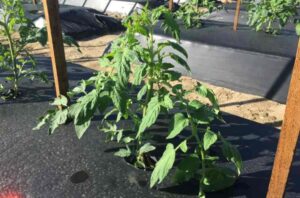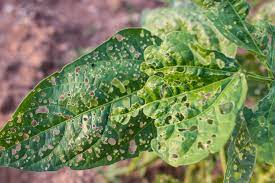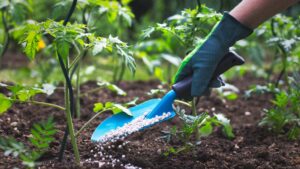Table of Contents
 Welcome to our comprehensive guide on troubleshooting the issue of yellow leaves on green bean plants. As gardening enthusiasts, we understand the joy and satisfaction of cultivating healthy and thriving vegetation. However, encountering yellowing leaves on your once vibrant green beans can be disheartening and raise concerns about the plant’s well-being.
Welcome to our comprehensive guide on troubleshooting the issue of yellow leaves on green bean plants. As gardening enthusiasts, we understand the joy and satisfaction of cultivating healthy and thriving vegetation. However, encountering yellowing leaves on your once vibrant green beans can be disheartening and raise concerns about the plant’s well-being.
This blog post will dive into the various factors contributing to green bean leaf discoloration and explore the underlying causes. By understanding the reasons behind this common problem, you’ll be better equipped to take proactive measures and ensure your green bean plants’ continued health and productivity.
From nutrient deficiencies and pest infestations to environmental stressors, we will examine each potential cause in detail, accompanied by clear visuals to aid identification. Moreover, we will provide practical solutions and effective remedies to address the issue and prevent its recurrence in the future.
You should also know the difference between Bush Beans And Pole Beans.
Common Causes of Yellow Leaves on Green Beans
Nutrient Deficiencies
Green bean plants require an adequate supply of essential nutrients to thrive. When they lack certain nutrients, their leaves may turn yellow, indicating possible deficiencies.
A. Nitrogen Deficiency
Nitrogen is crucial for leaf development and overall plant growth. When green beans lack nitrogen, their leaves begin to yellow, usually starting from the older leaves. To address this, consider using nitrogen-rich fertilizers or organic compost.
B. Iron Deficiency
Insufficient iron in the soil can lead to chlorosis, causing the leaves to turn yellow while the veins remain green. Adding iron chelates to the soil or using iron-fortified fertilizers can help rectify this deficiency.
C. Potassium Deficiency
Potassium is essential for photosynthesis and overall plant health. Yellowing of the edges or tips of leaves, along with a general yellowing, could indicate a potassium deficiency. Apply potassium-rich fertilizers to restore the plant’s health.
Overwatering or Underwatering
Improper watering practices can significantly impact green bean plants, leading to yellow leaves.
A. Overwatering
Excessive watering can drown the roots and deprive the plants of oxygen, leading to yellowing leaves. Ensure proper drainage and allow the soil to dry slightly between watering sessions.
B. Underwatering
On the other hand, underwatering can cause stress to the plant, leading to yellowing leaves that may eventually wither. Be consistent with watering and ensure the plants receive enough water during dry spells.
Pest Infestations
Pests can wreak havoc on green bean plants, causing physical damage and transmitting diseases.
A. Aphids
These tiny insects feed on plant sap and secrete honeydew, leading to yellow, distorted leaves. Introduce natural predators or use insecticidal soap to control aphid populations.
B. Spider Mites
Spider mites are common arachnid pests that feed on plant juices, causing stippling and yellowing of leaves. Regularly misting the leaves and applying neem oil can help manage these pests.
C. Whiteflies
Whiteflies feed on plant sap and excrete sticky honeydew, leading to yellowing and wilting leaves. Encourage beneficial insects or use yellow sticky traps to control whitefly populations.
If you’re confused about right time of cutting grass, you can visit out guide about when to cut the new grass and learn every thing about it.
Disease Infections
Fungal and bacterial diseases can cause yellowing and wilting of green bean leaves.
A. Bean Rust
This fungal disease leads to yellowish-orange spots on the leaves, eventually causing defoliation. Remove affected leaves and apply fungicides to prevent their spread.
B. Bacterial Blight
Bacterial blight causes yellowing and browning of leaves, with dark streaks along the veins. Practice crop rotation and use disease-resistant varieties to mitigate this issue.
C. Powdery Mildew
Powdery mildew appears as a white powdery coating on leaves, leading to yellowing and eventual leaf drop. Improve air circulation and apply fungicides as needed.
Environmental Stressors

Green beans are sensitive to environmental conditions; certain stressors can cause yellowing leaves.
A. Extreme Temperatures
Exposure to extreme heat or cold can stress the plants, yellowing leaves. Provide shade during scorching heat and avoid planting in frost-prone areas.
B. Excessive Sunlight
Intense sunlight can lead to sunburn and yellowing of leaves. Consider using shade cloth or relocating plants to a spot with partial shade.
C. Wind Damage
Strong winds can cause physical damage to leaves, resulting in yellowing and browning. Use windbreaks or barriers to protect plants from excessive wind exposure.
By understanding these common causes of yellow leaves on green beans, you can take appropriate measures to address the issues and ensure your green bean plants stay healthy and productive throughout the growing season.
How Do You Treat Yellow Leaves On Beans?
Treating yellow leaves on beans involves identifying the underlying cause and implementing appropriate remedies. Here’s a step-by-step guide to effectively address this issue:
Diagnose the Problem
Examine the yellow leaves closely and look for specific symptoms like discoloration patterns, spots, or pests. This will help you identify the root cause of the issue.
Nutrient Deficiencies

-
- Apply a nitrogen-rich fertilizer or add organic compost to the soil for nitrogen deficiency.
- For iron deficiency, use iron chelates or iron-fortified fertilizers to restore iron levels in the soil.
- For potassium deficiency, apply a potassium-rich fertilizer to promote healthy leaf development.
Adjust Watering Practices
-
- If overwatering is the issue, improve drainage and allow the soil to dry slightly between waterings.
- If underwatering is the problem, be consistent with watering and ensure the plants receive enough water during dry periods.
Combat Pest Infestations
-
- Introduce natural predators like ladybugs or lacewings to control aphid populations.
- Use insecticidal soap or neem oil to manage spider mites effectively.
- Implement yellow sticky traps or use reflective mulches to control whiteflies.
Address Disease Infections
-
- Remove and dispose of affected leaves for bean rust, and apply fungicides to prevent its spread.
- Practice crop rotation and use disease-resistant varieties to manage bacterial blight.
- Improve air circulation and apply fungicides to control powdery mildew.
Manage Environmental Stressors
-
- Provide shade during extreme heat to protect the plants from heat stress.
- Use shade cloth or relocate plants to areas with partial shade to prevent sunburn.
- Install windbreaks or barriers to shield plants from strong winds.
Prune Affected Leaves
If the yellowing is limited to specific leaves, carefully prune them to prevent the spread of any diseases or pests.
Preventive Measures
- Implement regular plant inspections.
- Maintain good garden hygiene.
- Practice proper crop rotation to minimize the risk of future issues.
Monitor Weather Conditions
Monitor weather forecasts to prepare for extreme conditions and take necessary precautions.
Soil Testing
Periodically test the soil to ensure it has the proper pH and nutrient levels, making adjustments to support healthy plant growth.
What Is The Best Fertilizer For Green Beans?

The best fertilizer for green beans typically contains a balanced blend of essential nutrients that support their growth and development. When choosing a fertilizer for green beans, it’s essential to consider their specific nutritional needs at different stages of growth.
1. Balanced NPK Fertilizer: Look for a fertilizer with a balanced ratio of nitrogen (N), phosphorus (P), and potassium (K). For example, a fertilizer labeled as 10-10-10 or 20-20-20 provides equal proportions of these three primary nutrients. Nitrogen supports leafy growth, phosphorus aids in root development and flower production, and potassium enhances overall plant health and resilience.
2. Organic Fertilizers: Organic fertilizers, derived from natural sources, are an excellent option for green beans. They release nutrients slowly, promoting steady and consistent growth without the risk of over-fertilization. Organic options include compost, well-rotted manure, fish emulsion, and seaweed-based fertilizers.
3. Slow-Release Fertilizers: Slow-release fertilizers are designed to release nutrients gradually over an extended period. These fertilizers reduce the risk of nutrient leaching and provide a steady supply of nutrients to the plants, supporting their growth over time.
4. Granular or Liquid Fertilizers: Fertilizers come in various forms, including granular and liquid formulations. Granular fertilizers are spread on the soil surface and watered in, while liquid fertilizers are mixed with water and applied directly to the plant’s root zone. Both types can be effective, so choose the one that best fits your gardening preferences and practices.
5. Micronutrients: Besides the primary nutrients (NPK), green beans also benefit from essential micronutrients like iron, magnesium, zinc, and others. Some fertilizers contain these micronutrients, which can be particularly beneficial if your soil is deficient in certain elements.
6. pH-Adjusted Fertilizers: Green beans prefer a slightly acidic to neutral soil pH (around 6.0 to 7.0). Consider using a fertilizer that adjusts the soil pH or ensuring that the pH of your soil aligns with the optimal range for green beans.
7. Water-Soluble Fertilizers: The plant roots can quickly absorb water-soluble fertilizers, making them a good choice for providing immediate nutrients when necessary, especially during periods of rapid growth or stress.
Always follow the instructions on the fertilizer packaging to avoid over-fertilization, which can lead to nutrient imbalances and potential damage to the plants. Additionally, consider the specific requirements of your green bean variety and the nutrient content of your soil to choose the best fertilizer that will support healthy, vigorous growth and a bountiful harvest.
What is a Homemade Fungicide For Green Beans?
A homemade fungicide for green beans can help protect your plants from fungal diseases without resorting to harsh chemicals. Here’s a simple and effective DIY fungicide recipe using common household ingredients:
Ingredients:
- Baking Soda
- Vegetable Oil (e.g., canola or sunflower oil)
- Liquid Dish Soap
- Water
Instructions:
- In a spray bottle, combine the following ingredients:
-
- 1 tablespoon of baking soda
- 1 tablespoon of vegetable oil
- 1 teaspoon of liquid dish soap
- 1 gallon (about 4 liters) of water
- Gently shake the spray bottle to ensure all the ingredients are well-mixed.
Application:
- Before applying the homemade fungicide, remove any infected leaves or plant debris from the vicinity of the green bean plants. Proper sanitation can help prevent the spread of fungal diseases.
- Spray the homemade fungicide solution evenly on the leaves and stems of the green bean plants, covering both the leaves’ upper and lower sides. Ensure good coverage but avoid excessive soaking.
- Apply the fungicide in the early morning or late afternoon to prevent leaf burn caused by the sun.
- Repeat the application every 1 to 2 weeks or after heavy rains to maintain protection.
Note:
- Always test the homemade fungicide on a small portion of the plant first to ensure it does not cause any adverse reactions before applying it to the entire plant.
- Avoid using this fungicide during hot or sunny weather to prevent leaf burn.
- Consider seeking professional advice and potentially using commercial fungicides for severe or persistent fungal infections.
Remember, while homemade fungicides can effectively prevent and manage fungal diseases, maintaining good gardening practices such as proper watering, ensuring adequate air circulation, and planting disease-resistant varieties can also contribute to keeping your green bean plants healthy and disease-free.
Also Read: How Long Does It Take For Grass Seed To Grow?
Final words
A few points discussed are the yellow leaves’ causes, symptoms, and cures on my green beans. To determine the problem, inspecting the plants closely and considering the growing conditions is important. Once the cause is identified, the appropriate steps can be taken to correct the problem. We would appreciate comments and additions in the comment section.
